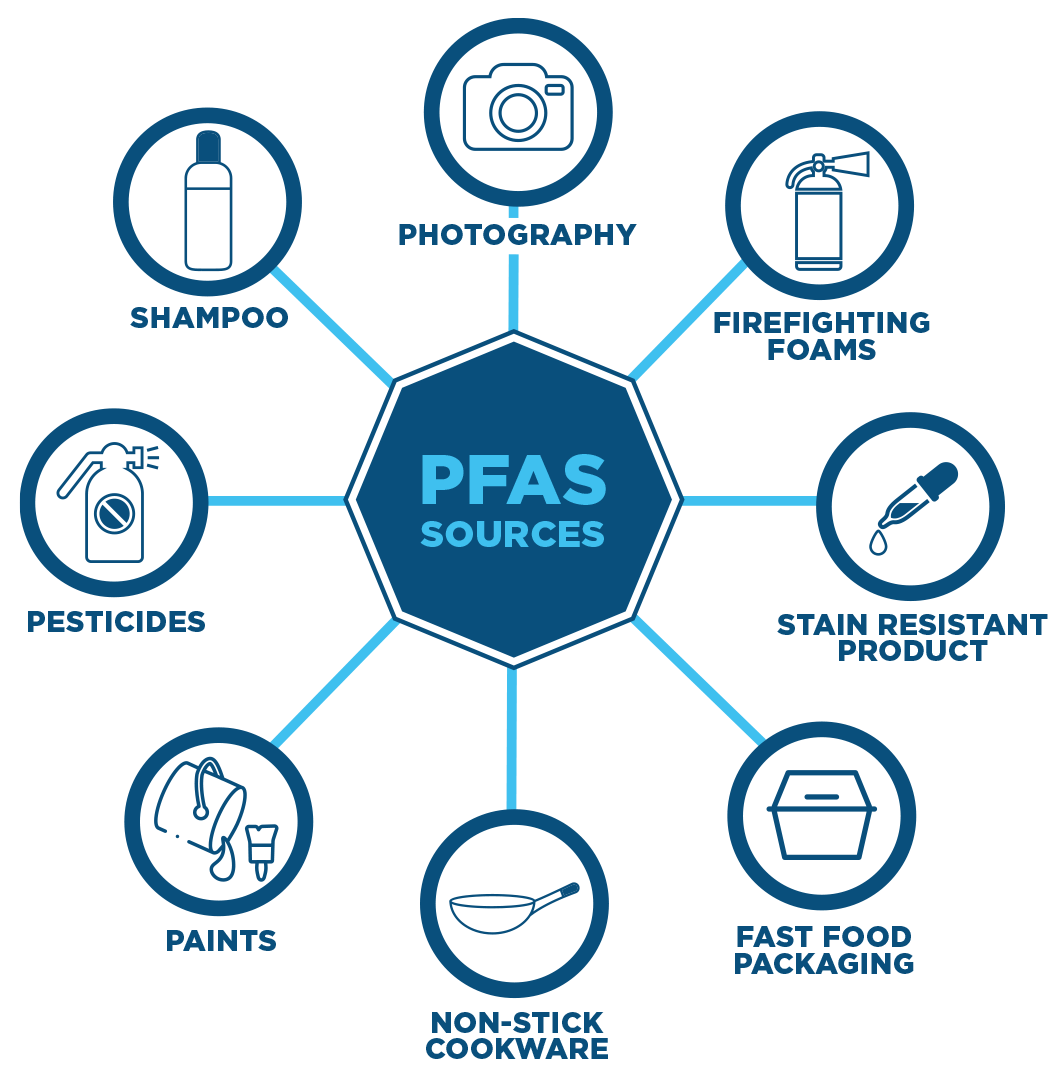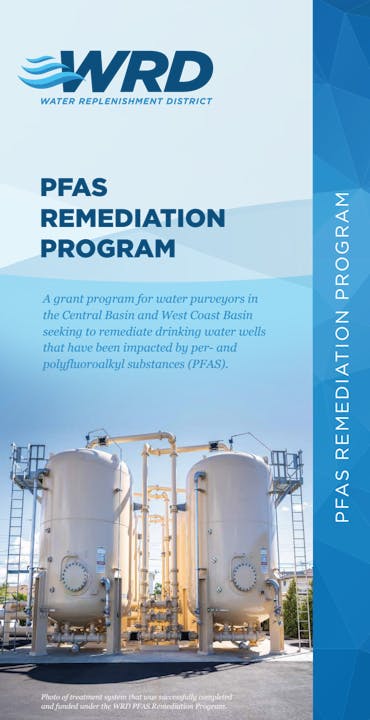PFAS Remediation Program
.png?ixlib=rb-1.1.0&w=2000&h=2000&fit=max&or=0&s=43e6126fa4ec20609bd584808645f993)
What are PFAS?
Per- and polyfluoroalkyl substances (PFAS) are a large group of man-made compounds, which include perfluorooctanoic acid (PFOA) and perfluorooctanesulfonic acid (PFOS), that have been manufactured and used around the globe since the 1940s. Because of their strong chemical bonds, PFAS were used in a variety of industries and consumer products, such as electroplating, firefighting foams (aqueous film-forming foam [AFFF]), food packaging, non-stick cookware (Teflon™), clothing (Gore-Tex ®), fabric protectant (Scotchgard™), stain-resistant carpet and furniture, and personal care products. Due to widespread use and unauthorized industrial releases, PFAS are found in the air, soil, drinking water supplies, water bodies, and livestock. PFAS are persistent in the environment, can accumulate within the human body over time, and can be toxic.

PFAS can be found in:
► Workplace, including production facilities or industries (e.g., chrome plating, electronics manufacturing, or oil recovery) that use PFAS.
► Drinking water, typically localized and associated with a specific facility (e.g., manufacturer, landfill, wastewater treatment plant, firefighter training facility).
► Living organisms, including fish, animals and humans, where PFAS can build up and persist over time.
Certain PFAS have been phased out of manufacturing in the United States. Although PFOA and PFOS are no longer manufactured in the United States, they are still produced internationally and can be imported in consumer goods such as carpet, leather and apparel, textiles, paper and packaging, coatings, rubber, and plastics.
(Source: United States Environmental Protection Agency)
On April 10, 2024, the United States Environmental Protection Agency (EPA) established national drinking water standards, i.e. Maximum Contaminant Levels (MCLs), for six PFAS, including PFOA, PFOS, perfluorohexane sulfonic acid (PFHxS), perfluorobutane sulfonic acid (PFBS), perfluorononanoic acid (PFNA), and hexafluoropropylene oxide dimer acid (HFPO-DA, commonly known as GenX Chemicals). An MCL of 4 parts per trillion (ppt) was established for PFOA and PFOS individually, and an MCL of 10 ppt was established for PFHxS, PFNA, and HFDO-DA, individually. In addition, a Hazard Index of 1.0 (unitless) was established for mixtures containing two or more of PFHxS, PFBS, PFNA, and HFPO-DA. These MCLs are legally enforceable limits in drinking water and all public water systems must monitor for these PFAS. Public water systems that have PFAS in drinking water which exceed one or more of these MCLs must take action to reduce levels of these PFAS in their drinking water and must provide notification to their customers/consumers of the violation.
PFOA and PFOS have been detected above MCLs in multiple drinking water wells located within the Central Basin, specifically within the Montebello Forebay. In response, the WRD Board of Directors launched the PFAS Remediation Program in August 2020, where currently over $60 million in grant funding has been established for water purveyors seeking to install treatment systems for drinking water wells located in the Central Basin and West Coast Basin that contain PFAS above MCLs. This program is one of the first in the State of California to administer grants specifically for the remediation of PFAS-impacted wells. Water purveyors interested in applying for the WRD PFAS Remediation Program may download the Initial Application here:
PFAS Remediation Program Initial Application.pdf
The PFAS Remediation Program is an essential part of WRD’s commitment to managing and protecting local groundwater resources for over four million residents living in the 43 cities within Southern Los Angeles County. By acting quickly and supporting water purveyors in their remediation of PFAS-impacted wells, we not only provide safe drinking water, but also prevent unwanted substances from spreading throughout our vital drinking water aquifers and ensure an uninterrupted supply of high-quality groundwater at affordable rates. In addition, WRD continues to work with our State and Federal partners to secure funding to provide treatment for contaminated drinking water sources, especially for underserved communities, where well closures can significantly increase the cost of tap water.

PFAS can be treated by various methods, with the most common ones being ion exchange (IX), granular activated carbon (GAC), and reverse osmosis (RO). These treatment technologies have been accepted by the State Water Resource Control Board's Division of Drinking Water (DDW) for the removal of PFAS. The cost to treat wells impacted by PFAS varies based on the level of PFAS contamination, the quantity of water being treated, and the technology selected. In 2021, WRD completed two pilot tests to evaluate the performance and life cycle costs for various IX and GAC media. Results from these pilot tests may aid water purveyors in the design of their PFAS treatment systems. The pilot test reports may be downloaded below.
Well # 7 Pilot Test Report.pdfWell # 10 Pilot Test Report.pdf
Frequently Asked Questions (FAQs)
.png?ixlib=rb-1.1.0&w=2000&h=2000&fit=max&or=0&s=43e6126fa4ec20609bd584808645f993)
People can be exposed to these chemicals and at different levels of exposure through a variety of pathways. For example, people can be exposed to low levels of PFAS through food, contaminated soil and water used to grow the food, food packaging containing PFAS, and equipment that uses PFAS for food processing.
People can also be exposed to PFAS if they are released during normal use, biodegradation, or disposal of consumer products that contain PFAS.
Drinking water can be a source of exposure in communities where these chemicals have contaminated water supplies. Such contamination is typically localized and associated with a specific facility, for example, an industrial facility where PFAS were produced or used to manufacture other products, or an oil refinery, airfield, or other location at which PFAS were used for firefighting.
(Source: United States Environmental Protection Agency)
Yes, PFAS, specifically PFOA and PFOS, have been detected in samples collected at wastewater treatment plants. The recycled water delivered to and treated by WRD’s advanced water treatment facilities is further purified using reverse osmosis, which is a State Water Resource Control Board's Division of Drinking Water (DDW)-approved method for the complete removal of PFAS from water. The highly purified water produced by WRD’s treatment facilities is utilized for groundwater recharge, thereby not only replenishing underlying aquifers but also improving groundwater quality.
In addition to the PFAS Remediation Program discussed above, WRD continues to assess groundwater quality in distinct aquifers using a network of over 350 nested monitoring wells, as we have done for over 60 years. WRD also continues to work with our State and Federal partners to secure funding to provide treatment for contaminated drinking water sources, especially for underserved communities, where well closures can significantly increase the cost of tap water.

As discussed above, the United States Environmental Protection Agency established Maximum Contaminant Levels (MCLs) on April 10, 2024, for certain PFAS. All public water systems have 3 years from this date to begin monitoring for PFAS, and if there is a detection of PFAS which exceed one or more of these MCLs, the public water system must take action to reduce levels of these PFAS in their drinking water and provide notification to their customers/consumers of the violation. These systems are required to implement treatment solutions within 5 years. The technologies typically employed to reduce PFAS concentrations include granular activated carbon, reverse osmosis, and ion exchange systems.
PFAS can be removed from water by various methods. The most common are reverse osmosis (RO), ion exchange (IX), and granular activated carbon (GAC). These technologies have been fully studied and are considered the “best available technologies" (or BATs) approved by the State Water Resource Control Board's Division of Drinking Water (DDW) for the removal of PFAS. WRD is currently producing fully advanced treated recycled water (using RO) at the Leo J. Vander Lans Advanced Water Treatment Facility (AWTF) in Long Beach and Robb Whitaker AWTF in Pico Rivera for injection at the three seawater injection barriers located along the coast and for surface spreading at inland areas in the Montebello Forebay, respectively.
Since 2019, water purveyors and others, have been sampling groundwater and collecting PFAS data in the Central Basin and West Coast Basin in response to State-wide requirements issued by the State Water Resource Control Board, Division of Drinking Water (DDW), and the Regional Water Quality Control Board (RWQCB). PFAS, in particular PFOA and PFOS, have been detected above Maximum Contaminant Levels in some production wells located in the Central Basin, specifically within the Montebello Forebay. Also in 2019 and 2020, WRD analyzed samples collected from our extensive network of nested groundwater monitoring wells for PFAS, with results published in our Regional Groundwater Monitoring Reports (specifically for Water Years 2019-2019 and 2019-2020), which can be downloaded from the WRD website at www.wrd.org/regional-groundwater-monitoring-report.
Yes. WRD has joined a class action lawsuit against 3M Company, E.I. DuPont de Nemours, Inc. and other manufacturers of aqueous film-forming foam (AFFF) for their involvement in the manufacture and sale of PFAS that have contaminated groundwater supplies within WRD’s service area.
WRD is represented by a consortium of firms with environmental contamination experience, including SL Environmental Law Group; Taft Stettinius & Hollister, LLP; Kelley Drye & Warren, LLP; Kennedy & Madonna, LLP; Douglas & London, PC; Levin Papantonio Thomas Mitchell Rafferty Proctor, Buchanan O’Brien Barr, Mougey, PA.

